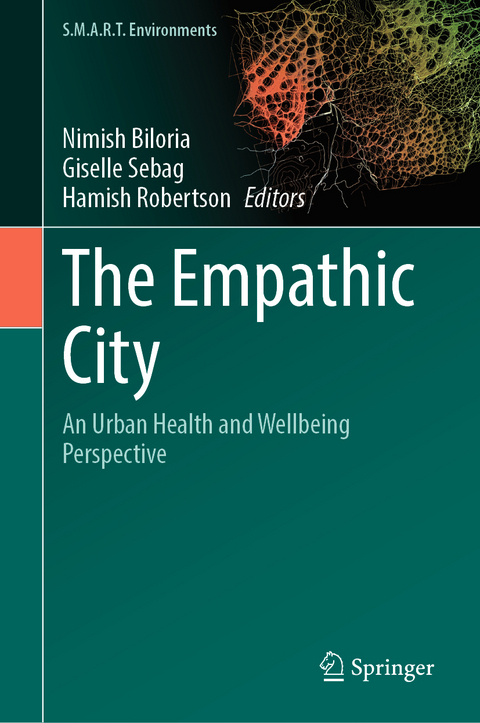
The Empathic City
Springer International Publishing (Verlag)
978-3-031-32839-8 (ISBN)
This book has a primary focus on inclusions for solutions to problems and not just more on the nature of the current and emerging problems that most other competing titles present. The book is also a true global representation of challenges and opportunities that have been encountered, addressed, and critiqued from a wide variety of contributors rather than academicians per se. In doing so, rather than focusing on techno-centric prowess and associated case studies of the west (as is the case in most competing titles), the book also equally emphasizes upon the vulnerabilities and mitigating solutions being developed and tested in the under-developed and developing nations. Besides this, the book also acquires an 'Equity' oriented focus and hints upon sustainable, inclusive modes of shaping our built environment throughout the contributing chapters. The book is also unique in the way it combines the chosen themes to provide a holistic coverage of the broader determinants of urban health and wellbeing, thus being better positioned to address SDG3 within one compact volume. The book also differs from a typical conference proceeding or a non-peer reviewed book since the book's highly theme specific approach is curated by a scientific peer review committee to carefully maintain diversity of contributions to the book.
Cities have a profound power to support or hinder human health and wellbeing in countless ways. Achieving greater health equity has emerged in recent years as a key priority and consideration when designing cities to promote health and wellbeing, although there is a dearth of evidence and practical examples of research translation to guide cities and communities. The book accordingly exemplifies a pluralistic approach to achieving urban health equity which recognises and addresses critical aspects of geography, age, race, background, socioeconomic status, disability, gender etc. With interdisciplinary science clearly pointing to the role of the neighbourhood environment as one of the most important health determinants, this book will undoubtedly lead the next generation of urban health actors to build contextually responsive, equitable, empathic cities to benefit residents around the world. The book, rather than being focused purely on academic propositions for building equitable cities, offers a unique multi-stakeholder perspective by collaborating with the International Society for Urban Health's 18th International Conference on Urban Health. This unique collaboration allows access to hundreds of scientists, architects, urbanists, multilaterals, policymakers, non-profit leaders, and grassroots organizers. The book captures the voices and concerns of such diverse cross-sectoral professionals and showcases findings that turn evidence into action and impact in communities around the world.
Chapter 14 is available open access under a Creative Commons Attribution 4.0 International License via link.springer.com.
lt;p>Dr. Nimish Biloria has multiple years of experience in transdisciplinary innovation within the sectors of urban science, architecture, and interaction design across Europe, Asia, and Australia. After working at one of the world's premier institutes for Architecture, the Delft University of Technology, the Netherlands, he is currently working at the University of Technology Sydney (UTS) as an Associate Professor. His area of research is Empathic Environments and it involves the study of human-environment interaction with its underpinnings in Architecture, Urban Science, Human Behavior, and Human-Computer Interaction. Under this research umbrella, he has amassed extensive research and design experience in leading multi-scalar transdisciplinary projects spanning the areas of Architecture, Smart Cities, Urban Informatics, Sustainable Mobility, Social Robotics, and Tangible and Embedded Interaction with a primary focus on enhancing human health and wellbeing.
Giselle Sebag, MPH, LEED AP ND is a high-impact, strategic leader with more than 15 years of experience in designing, managing, and guiding multidisciplinary urban health and development initiatives worldwide. She has demonstrated experience in working with complex international contexts and building healthy, inclusive and resilient cities. She also has a proven track record of establishing and maintaining solid working relationships with strategic partners, donors, and clients.
Dr. Hamish Robertson is a geographer with experience in health, ageing, disability and multicultural issues. His PhD research was on the geography of Alzheimer's disease in New South Wales, Australia. Dr. Robertson is interested in spatial science applications in the health, ageing and disability sectors including spatial visualisation as a tool for collaborative research and analysis. He also writes in the areas of big data, health informatics, 'race', diversity and cultural heritage issues.
Chapter 1. Towards a systemic understanding of equitable sustainability in cities: a conceptual framework.- Chapter 2. Assessing the person-environment fit framework for active ageing.- Chapter 3. Role of public parks and spaces in creating age-friendly cities.- Chapter 4. Neighbourhood outdoor shared spaces and mental well-being of the elderly: The case of a high-rise neighbourhood in Delhi.- Chapter 5. Healthy cities for adolescents: Learnings and reflections from Bhubaneshwar and Jaipur city.- Chapter 6. Reclaiming healthy cities through nature-based planning solutions.- Chapter 7. Spatiotemporal variability of urban greenspace and surface temperature in Dhaka city: A Public health aspect.- Chapter 8. Access to health promoting green space in relation to population density : A case study of Leuven (Belgium).- Chapter 9. Technology and ecology in a green mesh: a healthy alliance for the smart city.- Chapter 10. Evaluating Nature-based Solutions (NbS) as a tool for urban resiliencein the Global South.- Chapter 11. Differentials in medication non-adherence in India: Does place of living matter?.- Chapter 12. Geographical inequalities in health in public housing districts in the context of Rome: An observational study on the territory of Local Health Unit Roma 1.- Chapter 13. A Case Study: An Intersectoral Partnership Approach to Embedding Health in Land Use Planning.- Chapter 14. The impacts of an urban cable car system on liveability: a mixed methods study in Bogotá, Colombia.- Chapter 15. Precincts and promises.- Chapter 16. Conclusion.
| Erscheinungsdatum | 02.07.2023 |
|---|---|
| Reihe/Serie | S.M.A.R.T. Environments |
| Zusatzinfo | XXI, 373 p. 1 illus. |
| Verlagsort | Cham |
| Sprache | englisch |
| Maße | 155 x 235 mm |
| Gewicht | 784 g |
| Themenwelt | Medizin / Pharmazie ► Medizinische Fachgebiete |
| Naturwissenschaften ► Geowissenschaften | |
| Schlagworte | Determinants of health and wellbeing • Equity • Health Informatics • Landscape/Regional and Urban Planning • Public and environmental health • Salutogenic environments • Urban geography/urbanism • Urban health and well-being • Urban Planning and Design |
| ISBN-10 | 3-031-32839-6 / 3031328396 |
| ISBN-13 | 978-3-031-32839-8 / 9783031328398 |
| Zustand | Neuware |
| Haben Sie eine Frage zum Produkt? |
aus dem Bereich


